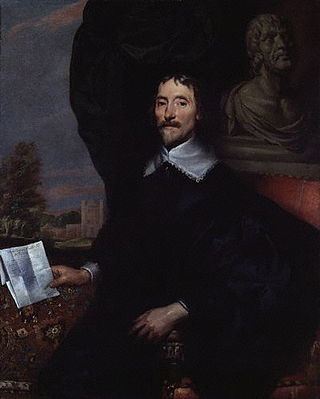Life
The second son of Sir Christopher Heydon, in 1613 he was keeper of the stores in Sandown Castle, Deal, Kent. He was knighted in August 1620. In 1627 he was appointed lieutenant of the ordnance in the place of his brother Sir William, who was killed in the expedition to the Isle of Rhé. [1]
Between 1627 and 1643 Heydon was actively occupied in furnishing men, provisions, arms, guns, and ammunition for the service of the king. When Charles I raised his standard at Nottingham on 22 August 1642, Heydon was in charge of cannon and ammunition at York. He soon joined the king, and accompanied the Royalist army from Shrewsbury towards London in October 1642. He acted as Lieutenant-General of the Ordnance with Charles's forces, and joined his Privy Council. He was made D.C.L. at Oxford on 20 December 1642. [1]
Heydon suffered for his support of the king, having his goods sequestrated. He died on 16 October 1653. [1]
Although it is important to distinguish Sir John from the astrologer John Heydon (1629-c. 1670), Lieutenant-General Heydon is also found to have developed alchemical theory and investigative practice. [2]

George Monck, 1st Duke of Albemarle JP KG PC was an English soldier, who fought on both sides during the Wars of the Three Kingdoms. A prominent military figure under the Commonwealth, his support was crucial to the Restoration of Charles II in 1660, who rewarded him with the title Duke of Albemarle and other senior positions.

Henry Montagu, 1st Earl of Manchester was an English judge, politician and peer.
James Howard, 3rd Earl of Suffolk,, and 3rd Baron Howard de Walden (1619–1688), eldest son of Theophilus Howard, 2nd Earl of Suffolk. Howard was honoured with the Knights of the Bath (K.B.) in 1626 and was a joint-commissioner of the parliament to Charles I the same year. He supported the Royalist cause in the English Civil War, and was a courtier after the Restoration of the monarchy in 1660. He was lord-lieutenant of Suffolk and Cambridgeshire and gentleman of the bedchamber, 1660–1682.

John Heydon was an English Neoplatonist occult philosopher, Rosicrucian, astrologer and attorney.

William Kerr, first Earl of Lothian of a new creation (1605–1675) was a Scottish nobleman.
Humphrey Moseley was a prominent London publisher and bookseller in the middle seventeenth century.

William Legge was an English royalist army officer, a close associate of Prince Rupert of the Rhine.
Anthony Hungerford of Black Bourton (1607/08–1657), was an English Member of Parliament who supported the Royalist cause during the English Civil War.
The Treaty of Uxbridge was a significant but abortive negotiation in early 1645 to try to end the First English Civil War.
The post of Lord President of Munster was the most important office in the English government of the Irish province of Munster from its introduction in the Elizabethan era for a century, to 1672, a period including the Desmond Rebellions in Munster, the Nine Years' War, and the Irish Rebellion of 1641. The Lord President was subject to the chief governor, but had full authority within the province, extending to civil, criminal and church legal matters, the imposition of martial law, official appointments, and command of military forces. Some appointments to military governor of Munster were not accompanied by the status of President. The width of his powers led to frequent clashes with the longer established courts, and in 1622 he was warned sharply not to "intermeddle" with cases which were properly the business of those courts. He was assisted by a Council whose members included the Chief Justice of Munster, another justice and the Attorney General for the Province. By 1620 his council was permanently based in Limerick.

Sir Thomas Lunsford was a Royalist colonel in the English Civil War.

Sir Thomas Aylesbury, 1st Baronet (1576–1657) was an English civil servant, Surveyor of the Navy from 1628 and jointly Master of the Mint from 1635, and a patron of mathematical learning. He was the great-grandfather of two British queens, Mary II and Anne.
Barnabas Oley (1602–1686) was an English churchman and academic. A royalist figure of the First English Civil War, he was also the first editor of George Herbert and Thomas Jackson, and a personal friend of Nicholas Ferrar. In old age he was archdeacon of Ely for a year.
Sir Robert Holborne was an English lawyer and politician, of Furnival's Inn and Lincoln's Inn. He acted, along with Oliver St. John, as co-counsel for John Hampden in the ship money case. He sat in the House of Commons between 1640 and 1642 and supported the Royalist cause in the English Civil War. He was attorney-general to the Prince of Wales, being knighted in 1643. He also published legal tracts.

Sir Francis Wortley, 1st Baronet (1591–1652), poet and politician who sat in the House of Commons between 1624 and 1626. He supported the Royalist cause in the English Civil War.

Sir Edward Hungerford (1596–1648) of Corsham, Wiltshire and of Farleigh Castle in Wiltshire, Member of Parliament, was a Parliamentarian commander during the English Civil War. He occupied and plundered Salisbury in 1643, and took Wardour and Farleigh castles.
Fitzwilliam Coningsby was an English politician who sat in the House of Commons in 1621 and in 1640. He supported the Royalist cause in the English Civil War.
Thomas Warmestry was Dean of Worcester from 1661 until his death.
George Ogilvy, 1st Lord Banff was a Scottish royalist army officer.

Rev. Humphrey Sydenham, "Silver Tongue Sydenham", was a royalist divine, famous for his sermons.
![]() This article incorporates text from a publication now in the public domain : Lee, Sidney, ed. (1891). "Heydon, John (d.1653)". Dictionary of National Biography . Vol. 26. London: Smith, Elder & Co.
This article incorporates text from a publication now in the public domain : Lee, Sidney, ed. (1891). "Heydon, John (d.1653)". Dictionary of National Biography . Vol. 26. London: Smith, Elder & Co.







